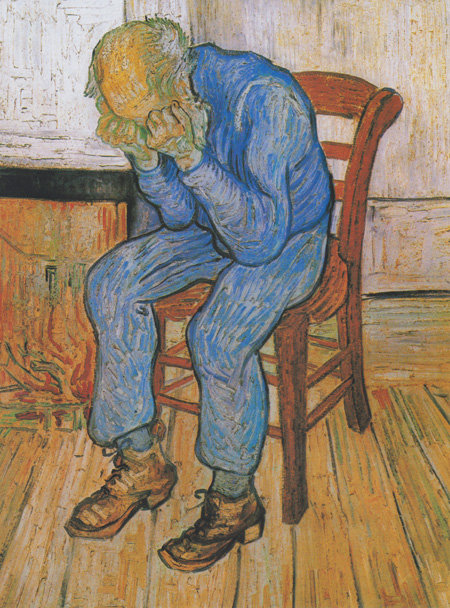An eternal world amid despair
An eternal world amid despair
Posted July. 16, 2020 07:34,
Updated July. 16, 2020 07:34

A white-haired man is weeping against fire. He appears to be in agony, as if tears may fall between his two fists that cover his face. His blue work clothes and worn out shoes are a symbol of the pain he must carry.
The oil painting was completed by Vincent Van Gogh just three months before his death. The artist had been going through the darkest period of his life, hospitalized in a mental hospital in Saint Remy. He frequently lost his consciousness due to repeated seizures and mental alienation. His health was horrible. “Things hardly go well. I cannot fathom the amount of sadness and unhappiness I have to further endure. I don’t know where to go. I managed to paint a few small pictures based on my memory, though,” he wrote to his brother Theo.
Despite worsening mental and physical conditions, Gogh did not give up on drawing. He used his old paintings because he could not examine nature nor find models to pose. This painting is a replica of pencil sketch and lithograph that he had formerly created in the Hague in 1882. The composition and character expression is almost exactly alike, even though he relied purely on his memory to replicate the drawing. The model of the painting is Adrianus Jacobus Zuyderland, a veteran living at a local almshouse. “Artist are obligated to make efforts to reflect their own thoughts on their work,” said the Dutch artist. What was the artist’s intention when he drew the same painting over agin?
It might have been interpreted as “complete despair” if it were not for the title of the work, “At Eternity’s Gate.” Perhaps Gogh wanted to express his faith in an eternal world that transcends pain and death. Maybe he wanted to console himself by believing that the end of his own life, in which he had lived in poverty, solitude, agony and madness, he would be at peace in an eternal world with God.
Headline News
- Med professors announce intention to leave hospitals starting Thursday
- Bridge honoring Sgt. Moon Jae-sik unveiled in Pennsylvania
- Chief of Staff Chung tells presidential secretaries to stay away from politics
- US FTC bans noncompete agreements
- N. Korea launches cyberattacks on S. Korea's defense companies







